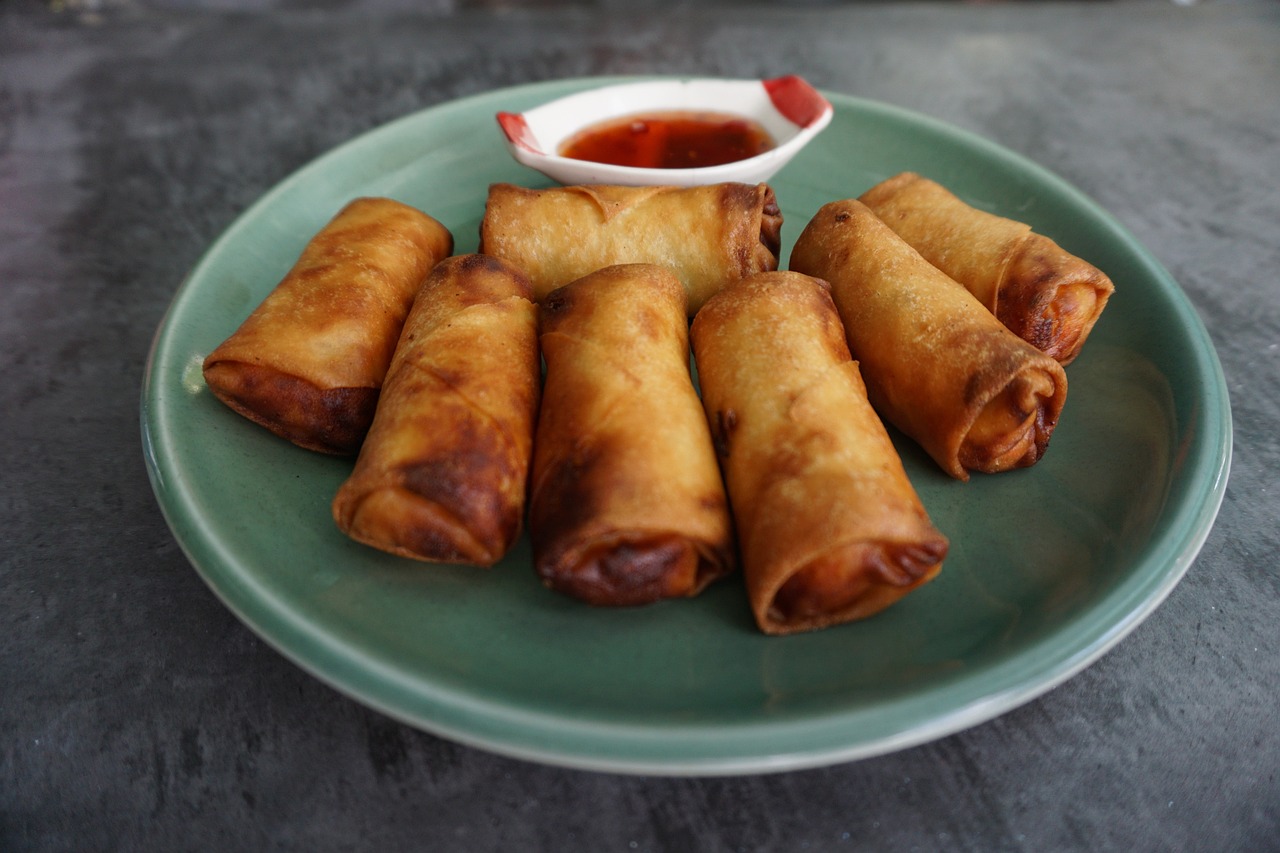Spring Rolls: Crispy Chinese Appetizers Filled with Vegetables and Meat

Spring rolls are a delightful and crispy Chinese appetizer that is beloved worldwide for its combination of fresh vegetables and savory meats encased in a thin, golden-brown wrapper. These delectable treats offer a burst of flavors and textures, making them a popular choice for both casual snacking and formal dining occasions.
Origin of Spring Rolls
The is a fascinating journey through the rich culinary history of Chinese cuisine. These crispy delights have been a beloved staple for centuries, with their roots deeply intertwined with Chinese traditions and festivities. Legend has it that spring rolls were originally created as a way to welcome the arrival of spring, hence their name. The thin, delicate wrappers symbolize the freshness and new beginnings associated with the season, making them not just a dish but a cultural emblem.
One of the earliest mentions of spring rolls can be traced back to the Eastern Jin Dynasty in China, dating back to the 3rd century AD. Initially, spring rolls were primarily served during the Spring Festival, a time of celebration and renewal. Over time, their popularity spread beyond festive occasions, becoming a beloved snack enjoyed throughout the year. As Chinese cuisine evolved, so did the preparation and fillings of spring rolls, leading to a myriad of variations that cater to different tastes and preferences.
Ingredients and Preparation
When it comes to making traditional Chinese spring rolls, the key lies in the ingredients and the meticulous preparation process. Let's delve into the essential components required to craft these delectable crispy appetizers that are beloved by many.
The primary ingredients for preparing authentic Chinese spring rolls typically include:
- Spring Roll Wrappers: Thin, delicate sheets made from a mixture of flour, water, and sometimes eggs, providing the crispy outer layer of the roll.
- Vegetables: Commonly used vegetables such as cabbage, carrots, bean sprouts, and mushrooms are finely julienned or shredded to create a flavorful filling.
- Protein: Diced or minced meat like pork, chicken, or shrimp can be added to the vegetable mixture for added taste and texture.
- Seasonings: Ingredients like garlic, ginger, soy sauce, and oyster sauce are used to season the filling, enhancing the overall taste profile.
- Oil: Oil is essential for frying the spring rolls to a perfect golden crispness.
Now, let's walk through the step-by-step process of preparing these delightful Chinese delicacies:
- Prepare the Filling: Sauté the vegetables, protein, and seasonings in a hot pan until cooked through and well combined.
- Assemble the Spring Rolls: Place a spoonful of the filling in the center of a spring roll wrapper, fold the sides over the filling, and roll tightly to form a neat cylinder.
- Seal the Edges: Secure the edges of the spring roll with a mixture of flour and water to prevent the filling from spilling during frying.
- Fry to Perfection: Heat oil in a pan or deep fryer, and carefully fry the spring rolls until they turn crispy and golden brown on all sides.
- Drain and Serve: Once cooked, remove the spring rolls from the oil, drain excess oil on paper towels, and serve hot with your favorite dipping sauce.
Mastering the art of preparing Chinese spring rolls requires patience and precision, but the end result is a delightful dish that bursts with flavors and textures. Experiment with different fillings and techniques to create your unique twist on this classic appetizer!
Variations and Regional Differences
When it comes to spring rolls, the variations and regional differences add a delightful twist to this beloved Chinese appetizer. Each region puts its unique spin on the classic dish, resulting in a diverse range of flavors and fillings that cater to different palates. Let's dive into the world of spring roll variations and explore how they differ across various regions.
In Northern China, spring rolls are known for their thicker and chewier wrappers, which provide a satisfying contrast to the crunchy filling. These rolls are often filled with a hearty mixture of shredded cabbage, carrots, and pork, creating a savory and robust flavor profile.
On the other hand, Southern Chinese spring rolls are characterized by their thin and delicate wrappers that shatter upon the first bite, revealing a burst of flavors. The fillings in Southern spring rolls tend to be lighter and fresher, with ingredients like shrimp, bean sprouts, and fragrant herbs taking center stage.
Traveling beyond China, you'll encounter Vietnamese summer rolls, a refreshing take on the traditional spring roll. These translucent rice paper rolls are typically filled with fresh herbs, vermicelli noodles, and protein such as shrimp or grilled pork, offering a lighter and healthier alternative to fried spring rolls.
In Thailand, spring rolls, known as "Po Pia Tod," are often served as a street food snack. These rolls feature a crispy exterior and a sweet and tangy filling that includes ingredients like jicama, carrots, and glass noodles. They are commonly enjoyed with a side of spicy dipping sauce for an extra kick.
When exploring the global variations of spring rolls, you'll come across fusion creations that blend traditional flavors with modern twists. From Japanese-inspired sushi spring rolls to Mexican-inspired avocado and black bean spring rolls, the possibilities are endless, showcasing the versatility of this beloved appetizer.
Serving and Dipping Sauces
When it comes to serving spring rolls, presentation plays a crucial role in enhancing the overall dining experience. The crispy exterior of the rolls should be showcased to entice the appetite of the diners. Placing the spring rolls on a bed of fresh lettuce leaves or vibrant garnishes can add a pop of color to the dish, making it visually appealing.
Additionally, serving spring rolls with an assortment of dipping sauces can elevate the flavors and provide a customizable experience for each diner. Popular dipping sauces include:
- Soy Sauce: A classic choice that adds a salty umami flavor to the rolls.
- Sweet Chili Sauce: Offers a balance of sweetness and heat, enhancing the taste of the rolls.
- Plum Sauce: A slightly tangy and sweet sauce that complements the savory filling of the spring rolls.
- Hoisin Sauce: Known for its rich and sweet flavor, perfect for dipping crispy spring rolls.
These dipping sauces not only add depth to the flavor profile of the spring rolls but also allow diners to experiment with different combinations to suit their preferences. The art of dipping the rolls into the sauce, balancing the flavors, and savoring each bite adds an interactive element to the dining experience.
Moreover, serving spring rolls with a side of fresh herbs, such as cilantro, mint, or Thai basil, can enhance the aromatic quality of the dish. These herbs not only provide a burst of freshness but also offer a contrast to the crispy texture of the rolls, creating a harmonious balance of flavors.
For a visually appealing presentation, consider arranging the spring rolls on a decorative platter or serving them in individual portions for a more refined touch. Garnishing the dish with sesame seeds, chopped peanuts, or a drizzle of sesame oil can add a gourmet flair to the presentation, making it a feast for both the eyes and the taste buds.
Health Benefits and Nutritional Information
When it comes to health benefits and nutritional information, spring rolls can offer a delightful balance of flavors and nutrients. Packed with fresh vegetables, lean proteins, and aromatic spices, these crispy Chinese appetizers can be a wholesome addition to your diet. Let's delve into the nutritional goodness that spring rolls bring to the table:
- Rich in Vitamins and Minerals: Traditional spring rolls are typically filled with a variety of vegetables such as cabbage, carrots, and mushrooms, providing essential vitamins like A, C, and K, as well as minerals like potassium and folate.
- Low in Calories: Compared to deep-fried snacks, spring rolls are usually lighter in calories, especially when baked or air-fried. This makes them a healthier option for those looking to enjoy a crispy treat without the guilt.
- Good Source of Fiber: The vegetable fillings in spring rolls contribute to their fiber content, promoting digestive health and aiding in weight management by keeping you feeling full and satisfied.
- Protein Boost: If filled with lean meats or tofu, spring rolls can be a source of protein, which is essential for muscle repair, energy production, and overall body function.
By choosing high-quality ingredients and cooking methods that prioritize nutrition, you can elevate the health benefits of spring rolls even further. Opting for whole wheat wrappers, using minimal oil, and pairing them with a light dipping sauce can enhance the nutritional profile of this beloved appetizer.



 HazalVardal
HazalVardal 





